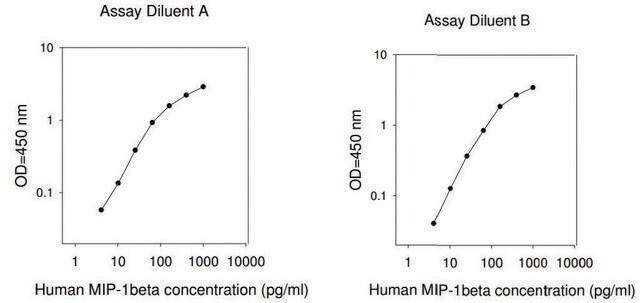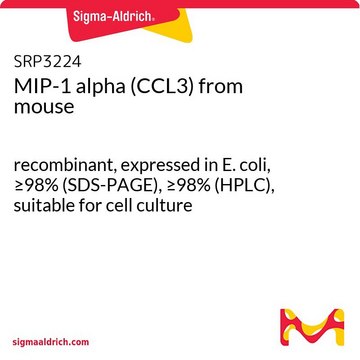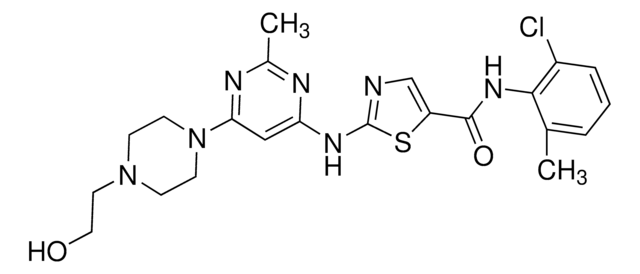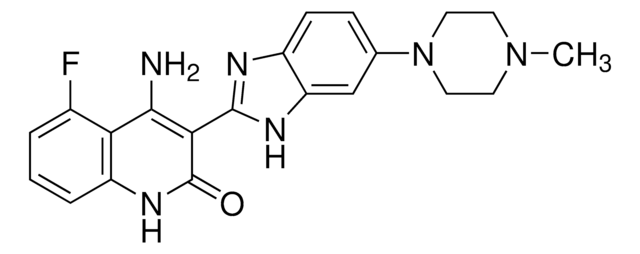おすすめの製品
由来生物
human
リコンビナント
expressed in E. coli
アッセイ
≥98% (HPLC)
≥98% (SDS-PAGE)
フォーム
lyophilized
分子量
7.6 kDa
包装
pkg of 10 μg
テクニック
cell culture | mammalian: suitable
不純物
<0.1 EU/μg endotoxin, tested
色
white to off-white
UniProtアクセッション番号
輸送温度
wet ice
保管温度
−20°C
遺伝子情報
human ... CCL4(6351)
詳細
Both MIP-1α and MIP-1β (macrophage inflammatory proteins-1α and β) are structurally and functionally related CC chemokines. They are secreted by activated human monocytes and peripheral blood lymphocytes. The gene encoding this protein is localized on human chromosome 17q12. Both human and murine MIP-1α and MIP-1β are active on human and murine hematopoietic cells. Recombinant human MIP-1β is a 7.6kDa protein containing 69 amino acid residues, including the four highly conserved cysteine residues present in CC chemokines.
生物化学的/生理学的作用
MIP-1α and MIP-1β (macrophage inflammatory proteins-1α and β) participate in the host response to invading bacterial, viral, parasite and fungal pathogens by regulating the trafficking and activation state of selected subgroups of inflammatory cells e.g. macrophages, lymphocytes and natural killer (NK) cells. While both MIP-1α and MIP-1β exert similar effects on monocytes their effect on lymphocytes differ; with MIP-1α selectively attracting CD8+ lymphocytes and MIP-1β (also known as C-C motif chemokine ligand 4) selectively attracting CD4+ lymphocytes. Additionally, MIP-1α and MIP-1β have also been shown to be potent chemoattractants for B cells, eosinophils and dendritic cells.
シーケンス
APMGSDPPTA CCFSYTARKL PHNFVVDYYE TSSLCSQPAV VFQTKRGKQV CADPSESWVQ EYVYDLELN
物理的形状
凍結乾燥品(添加物不含)。
再構成
バイアルは、開封前に遠心してください。水で濃度0.1~1.0 mg/mLに復元してください。ボルテックスは行なわないでください。水溶液は2~8°Cで最長1週間保存できます。長期保存には、担体タンパク質(0.1% BSAなど)含有バッファーでさらに希釈し、1回の使用量ずつに分注して-20~-80°Cで保存することを推奨します。
保管分類コード
11 - Combustible Solids
WGK
WGK 3
引火点(°F)
Not applicable
引火点(℃)
Not applicable
適用法令
試験研究用途を考慮した関連法令を主に挙げております。化学物質以外については、一部の情報のみ提供しています。 製品を安全かつ合法的に使用することは、使用者の義務です。最新情報により修正される場合があります。WEBの反映には時間を要することがあるため、適宜SDSをご参照ください。
Jan Code
SRP3115-10UG:
最新バージョンのいずれかを選択してください:
S D Wolpe et al.
The Journal of experimental medicine, 167(2), 570-581 (1988-02-01)
We report the identification and purification of a new inflammatory monokine synthesized by the macrophage tumor cell line RAW 264.7 in response to endotoxin. This monokine, which we term "macrophage inflammatory protein" (MIP), is a doublet with an apparent molecular
Biology of the RANTES/SIS cytokine family.
T J Schall
Cytokine, 3(3), 165-183 (1991-05-01)
CCL3L1 and CCL4L1 chemokine genes are located in a segmental duplication at chromosome 17q12.
Modi WS
Genomics, 83(4), 735-738 (2004)
K Hieshima et al.
Journal of immunology (Baltimore, Md. : 1950), 159(3), 1140-1149 (1997-08-01)
By searching the expressed sequence tag (EST) database, we identified partial cDNA sequences encoding a polypeptide with significant sequence identity to the human CC chemokine macrophage-inflammatory protein-1 alpha (MIP-1 alpha)/LD78 alpha. We determined the complete cDNA sequence that contained a
MicroRNA-125b modulates inflammatory chemokine CCL4 expression in immune cells and its reduction causes CCL4 increase with age.
Cheng NL
Aging Cell, 14(2), 200-208 (2015)
ライフサイエンス、有機合成、材料科学、クロマトグラフィー、分析など、あらゆる分野の研究に経験のあるメンバーがおります。.
製品に関するお問い合わせはこちら(テクニカルサービス)








